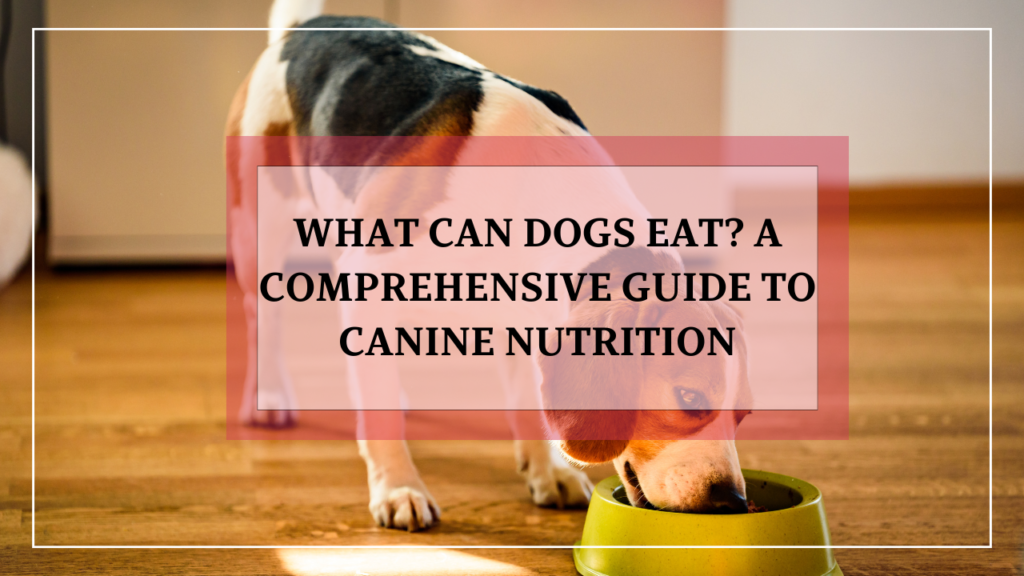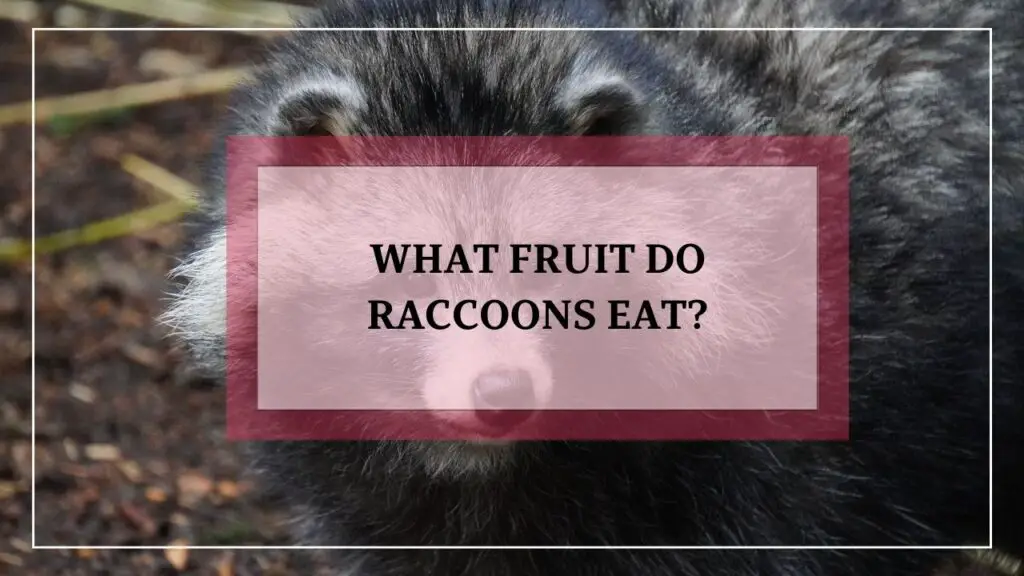Understanding Your Dog’s Dietary Needs

The Basics of Canine Nutrition
When it comes to what dogs can eat, understanding their dietary needs is paramount. Just like humans, dogs require a balanced diet to thrive. This means their meals should consist of essential nutrients, including proteins, fats, carbohydrates, vitamins, and minerals. Each of these components plays a crucial role in maintaining your dog’s health and well-being.
- Proteins are vital for growth and tissue repair. They help build muscles and support the immune system. Sources include meat, fish, and eggs.
- Fats provide a concentrated source of energy and are essential for the absorption of fat-soluble vitamins (A, D, E, and K). Healthy fat sources include fish oil and chicken fat.
- Carbohydrates are not as critical for dogs as they are for humans, but they can still provide energy. Ingredients like brown rice, sweet potatoes, and peas are beneficial carbohydrate sources.
- Vitamins and minerals support various body functions. For example, calcium is crucial for bone health, while vitamin E acts as an antioxidant.
When determining what dogs can eat, it’s important to consider the age and size of your pet. Puppies have different nutritional needs compared to adult or senior dogs. Puppies require more protein and fat to support their rapid growth, while senior dogs may need lower-calorie diets to maintain a healthy weight.
How Dietary Needs Vary by Dog Type
Differences in Diet for Puppies, Adult Dogs, and Senior Dogs
- Puppies: Their food should be rich in calories and nutrients to support growth and development. Look for high-quality puppy formulas that contain around 22-32% protein and 8-22% fat.
- Adult Dogs: They require a balanced diet with moderate protein (18-25%) and fat (8-15%). Feeding adult dogs a high-quality commercial dog food will often meet their needs.
- Senior Dogs: As dogs age, their metabolism slows, and their dietary needs change. Senior dogs benefit from lower-calorie diets with high-quality protein to maintain muscle mass while preventing obesity. Look for formulas specifically designed for older dogs, often containing around 18% protein and lower fat content.
Variations Based on Breed Size
Dietary requirements can also vary by breed size:
- Small Breeds: Small dogs often have faster metabolisms and may require calorie-dense food. They typically do better with smaller kibble to accommodate their smaller mouths.
- Medium Breeds: Medium-sized dogs require a balanced diet that provides adequate energy without excessive calories. They can thrive on standard dog food formulated for all breeds.
- Large Breeds: Large dogs are prone to specific health issues like hip dysplasia. Therefore, it’s crucial to feed them food designed to support joint health, often with glucosamine and omega fatty acids.
By understanding these foundational elements of canine nutrition, you can make informed choices about what dogs can eat. It’s crucial to provide a balanced diet tailored to your dog’s specific needs, which will help promote a long, healthy, and active life.
25 Safe Foods for Dogs
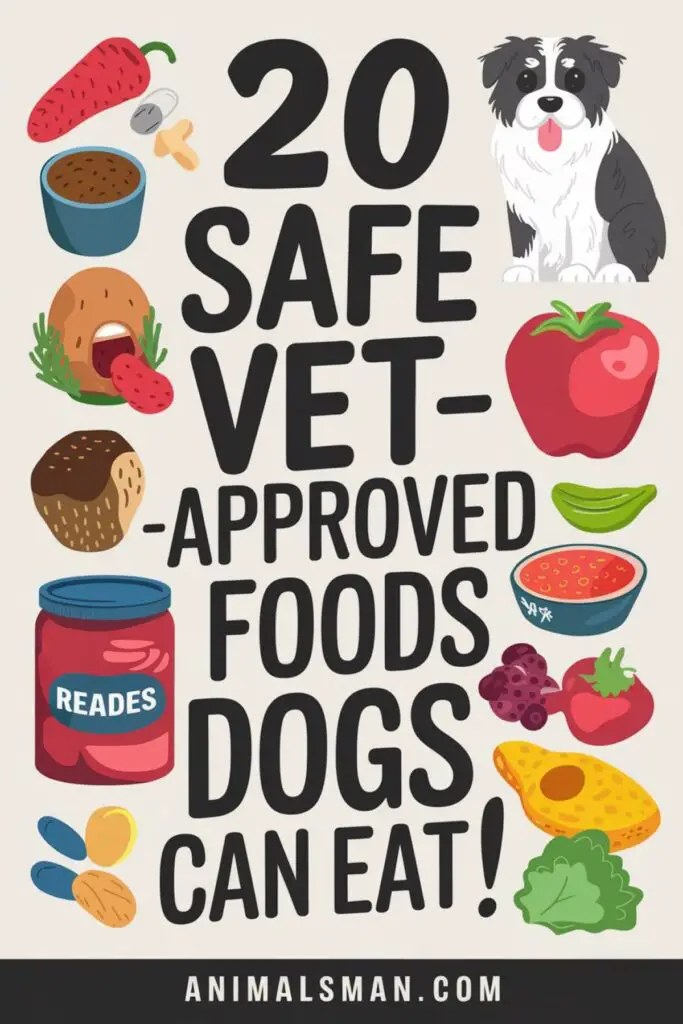
Human Foods Dogs Can Eat
When considering what dogs can eat, it’s essential to know which human foods are safe and beneficial for our canine companions. Sharing human food can be a great way to bond with your dog while also providing them with nutritious snacks. Below is an expanded list of safe human foods that dogs can enjoy in moderation, along with some in-depth information on their health benefits and precautions.
Fruits
- Apples: Apples are rich in vitamins A and C, promoting good vision and a healthy immune system. The high fiber content helps with digestion. Ensure you remove the seeds and core, as they can be harmful.
- Bananas: A good source of potassium, bananas support heart and kidney function. They also contain vitamins B6 and C, which help regulate blood sugar. However, due to their high sugar content, offer them in moderation.
- Blueberries: These small fruits are packed with antioxidants that combat oxidative stress and reduce the risk of certain diseases. They are also low in calories, making them an ideal snack.
- Watermelon: Watermelon is hydrating and rich in vitamins A, B6, and C. It also contains potassium. Always remove the seeds and rind before serving, as they can be choking hazards.
- Strawberries: Strawberries are another excellent source of vitamin C and antioxidants. They contain fiber and enzymes that help whiten your dog’s teeth. Like bananas, they should be given in moderation due to their sugar content.
- Pineapple: Fresh pineapple is full of vitamins and minerals, including vitamin C and manganese. It also contains bromelain, an enzyme that can help with digestion. However, avoid canned pineapple as it may contain added sugars.
- Cantaloupe: This hydrating fruit is low in calories and rich in vitamins A and C. Its high water content makes it a great snack, especially during hot weather. As with other fruits, ensure it’s served in moderation.
Vegetables
- Carrots: Carrots are low in calories and high in fiber, which aids in digestion. They are also a good source of beta-carotene, which promotes eye health. Many dogs enjoy crunching on raw carrots.
- Green Beans: Low in calories and high in fiber, green beans can help maintain a healthy weight. They are a great addition to your dog’s diet, whether served raw or cooked.
- Sweet Potatoes: Cooked sweet potatoes are packed with vitamins A, C, and B6, as well as fiber. They can be served mashed, baked, or even dehydrated as treats.
- Pumpkin: Plain canned pumpkin (not the spiced pie filling) is excellent for dogs’ digestive health due to its high fiber content. It can help alleviate both diarrhea and constipation.
- Broccoli: Broccoli is rich in vitamins C and K, as well as fiber. It can be served raw or cooked but should be given in moderation to prevent gastrointestinal upset.
- Spinach: This leafy green is high in iron, vitamins A, C, and K, and antioxidants. While it can be offered to dogs, it should be given in moderation due to oxalic acid, which can interfere with calcium absorption.
- Zucchini: Low in calories and high in nutrients, zucchini can be a crunchy treat for dogs. It is also a good source of vitamins A and C.
Proteins
- Chicken: Cooked, unseasoned chicken is an excellent source of lean protein. Always remove bones and skin to prevent choking and avoid fat.
- Turkey: Like chicken, turkey is a healthy protein option. It’s best to offer it cooked and without any seasoning or bones.
- Fish: Fish such as salmon and sardines are rich in omega-3 fatty acids, which promote healthy skin and coat. Cooked fish should be deboned and served without seasoning or added oils.
- Eggs: Cooked eggs are a great source of protein and contain essential amino acids. They can be scrambled or hard-boiled, but avoid feeding raw eggs due to the risk of salmonella.
- Beef: Lean cuts of beef can be a good protein source. Ground beef is often used in homemade dog treats or meals, but it should be cooked thoroughly and drained of excess fat.
- Lamb: Lamb is another protein option that some dogs may tolerate better than beef or chicken, especially if they have allergies. Ensure it’s cooked and unseasoned.
- Tofu: While not a traditional protein source for dogs, plain, cooked tofu can be an option for vegetarian or vegan diets. It’s high in protein but should be given in moderation due to its fat content.
Grains
- Rice: Both white and brown rice are easily digestible and can help soothe upset stomachs. They can be especially beneficial for dogs recovering from gastrointestinal issues.
- Oatmeal: Oatmeal is a good source of fiber and can help regulate bowel movements. It’s also beneficial for dogs with wheat allergies.
- Whole Grains: Quinoa and barley are excellent sources of protein, fiber, and essential nutrients. They can be incorporated into homemade dog meals or treats.
- Pasta: Plain, cooked pasta can be given in moderation. It provides carbohydrates for energy but should not replace a balanced diet.
Foods to Avoid
While there are many safe foods for dogs, there are also several that should be avoided, including:
- Chocolate: Contains theobromine, which is toxic to dogs.
- Grapes and Raisins: Can cause kidney failure.
- Onions and Garlic: Can damage red blood cells.
- Avocado: Contains persin, which can be harmful.
- Alcohol: Even small amounts can be toxic.
- Xylitol: A sugar substitute found in many sugar-free products; it can cause a rapid insulin release, leading to hypoglycemia.
Foods That Are Toxic to Dogs
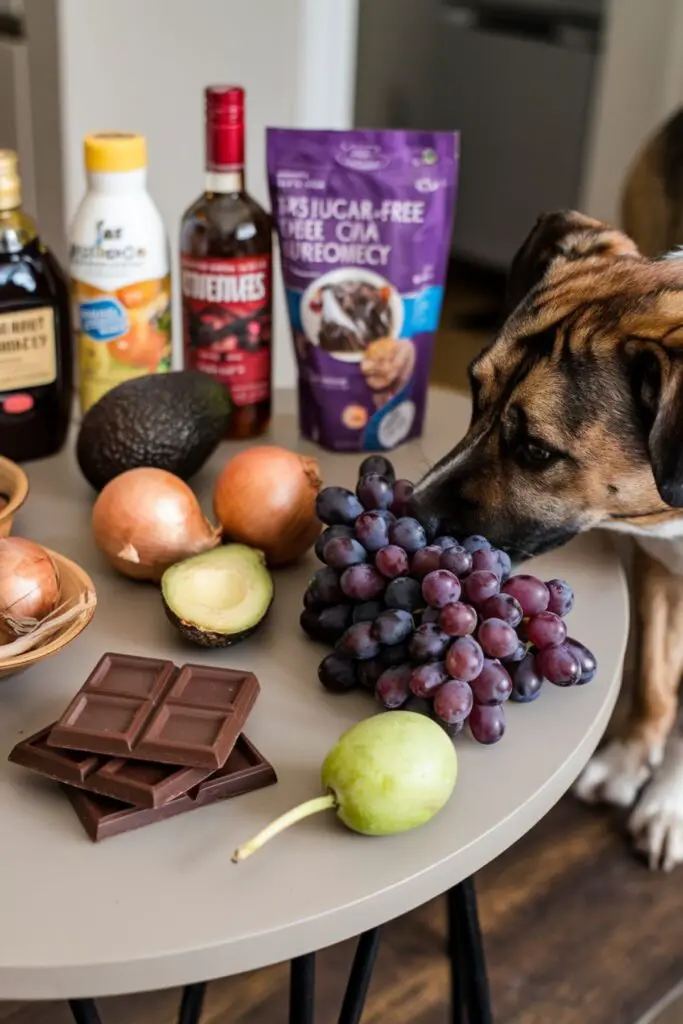
Understanding Dog Food Toxicity
When discussing what dogs can eat, it’s just as crucial to know what they cannot eat. Many common foods can be toxic to dogs and may lead to serious health issues. Understanding these dangers is essential for every pet owner to ensure their furry friend stays safe and healthy.
Common Toxic Foods
- Chocolate:
- Why It’s Toxic: Contains theobromine and caffeine, both of which are harmful to dogs.
- Symptoms of Poisoning: Vomiting, diarrhea, rapid breathing, increased heart rate, and seizures.
- Severity: The severity of the effects depends on the type and amount of chocolate consumed. Dark chocolate and baking chocolate contain higher levels of theobromine than milk chocolate.
- Grapes and Raisins:
- Why They’re Toxic: The exact substance causing toxicity is unknown, but ingestion can lead to acute kidney failure.
- Symptoms of Poisoning: Vomiting, lethargy, diarrhea, and decreased appetite.
- Severity: Even small amounts can be harmful; immediate veterinary care is essential if ingestion occurs.
- Onions and Garlic:
- Why They’re Toxic: Contains compounds (thiosulfate) that can damage red blood cells, leading to anemia.
- Symptoms of Poisoning: Weakness, lethargy, reduced appetite, and reddish-brown urine.
- Severity: Toxicity can occur with small amounts over time, so it’s crucial to avoid all forms, including powdered forms.
- Avocado:
- Why It’s Toxic: Contains persin, which can cause vomiting and diarrhea in dogs.
- Symptoms of Poisoning: Stomach upset, vomiting, and potential respiratory distress.
- Severity: Most dogs will tolerate small amounts, but it’s best to avoid giving any part of the avocado.
- Alcohol:
- Why It’s Toxic: Even small amounts can lead to alcohol poisoning in dogs, which affects the central nervous system.
- Symptoms of Poisoning: Vomiting, disorientation, tremors, and potential coma.
- Severity: Highly dangerous; any exposure requires immediate veterinary intervention.
- Xylitol:
- Why It’s Toxic: A sugar substitute found in sugar-free products like gum, candies, and baked goods that can cause a rapid release of insulin.
- Symptoms of Poisoning: Vomiting, lethargy, loss of coordination, seizures, and liver failure.
- Severity: Very toxic; even small amounts can cause severe reactions.
- Caffeine:
- Why It’s Toxic: Similar to chocolate, caffeine stimulates the central nervous system and can be fatal in dogs.
- Symptoms of Poisoning: Restlessness, rapid breathing, heart palpitations, and muscle tremors.
- Severity: All forms of caffeine (coffee, tea, energy drinks) are dangerous; avoid exposure completely.
- Macadamia Nuts:
- Why They’re Toxic: The exact mechanism is unknown, but these nuts can cause weakness, tremors, and hyperthermia in dogs.
- Symptoms of Poisoning: Lethargy, vomiting, and increased heart rate.
- Severity: Toxicity can occur with even small quantities, so it’s best to keep these nuts away from dogs.
- Raw Dough:
- Why It’s Toxic: When ingested, raw dough can rise in a dog’s stomach, leading to severe bloating and potential rupture of the stomach.
- Symptoms of Poisoning: Abdominal pain, vomiting, and lethargy.
- Severity: This is a serious emergency that requires immediate veterinary attention.
- Certain Types of Fish:
- Why They’re Toxic: Some fish, like raw salmon, can carry parasites that lead to a condition called salmon poisoning disease.
- Symptoms of Poisoning: Vomiting, diarrhea, and fever.
- Severity: Cooked fish is generally safe, but raw fish should be avoided.
Precautions to Take
- Educate Yourself and Others: Ensure everyone in your household understands which foods are safe and which are toxic to dogs. This is especially important during gatherings or when sharing food.
- Secure Food Storage: Store all human food in secure containers and keep harmful items out of reach to prevent accidental ingestion.
- Check Labels: Always read ingredient labels on packaged foods for xylitol and other harmful substances before sharing with your dog.
- Know the Signs: Familiarize yourself with the symptoms of food poisoning in dogs. Early recognition can make a significant difference in treatment outcomes.
- Emergency Preparedness: Keep the contact information for your veterinarian and the nearest emergency animal clinic readily available. If you suspect your dog has ingested something toxic, seek immediate help.
How to Introduce New Foods
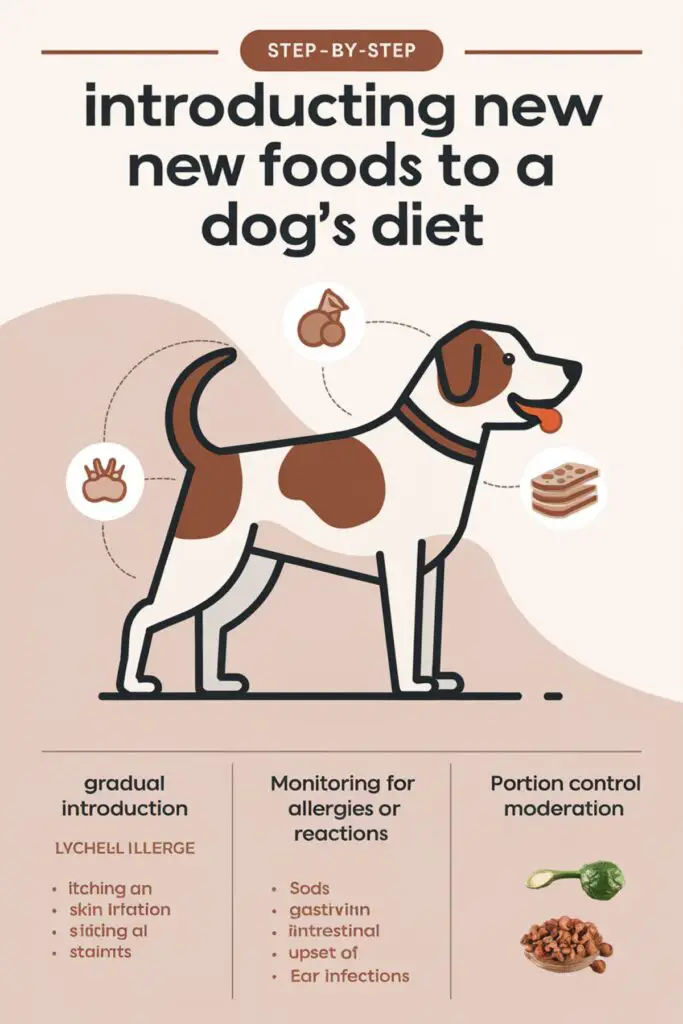
Steps for Safely Introducing New Foods
Introducing new foods to your dog’s diet can be exciting, but it must be done cautiously to ensure their safety and well-being. Here’s how to introduce new foods effectively:
- Gradual Introduction:
- Start by incorporating a small amount of the new food into your dog’s existing diet. A good rule of thumb is to replace about 10% of their current food with the new option for the first few days.
- Gradually increase the proportion of the new food over the course of a week, ultimately transitioning to 100% if your dog tolerates it well.
- Monitoring for Allergies or Reactions:
- During the introduction period, closely monitor your dog for any signs of allergies or digestive issues. Common signs include itching, redness, swelling, or gastrointestinal upset such as vomiting or diarrhea.
- If any adverse reactions occur, revert to their previous diet and consult your veterinarian for guidance.
- Portion Control and Moderation:
- When introducing new foods, practice portion control. Start with small amounts to prevent overfeeding and allow your dog’s digestive system to adjust to the new ingredient.
- Avoid giving too many different new foods at once. Stick to one new food at a time, which helps identify any potential causes of allergies or digestive upset.
Signs of Food Allergies in Dogs
As you explore what dogs can eat, it’s essential to be aware of potential food allergies. Symptoms can manifest in various ways, and prompt recognition is crucial for your dog’s health. Here are common signs to watch for:
- Itching and Skin Irritation: If your dog frequently scratches, licks, or bites at their skin, it may indicate an allergic reaction. Look for redness, swelling, or hotspots on the skin.
- Gastrointestinal Upset: Symptoms such as vomiting, diarrhea, or changes in appetite can suggest food allergies. Be vigilant about any changes in your dog’s eating habits or bowel movements.
- Ear Infections: Recurring ear infections or excessive scratching at the ears can be associated with food allergies. Pay attention to any unusual discharge or foul odor.
- Behavioral Changes: If your dog seems more anxious, restless, or irritable than usual, it could be a sign of discomfort related to allergies.
If you notice any of these symptoms after introducing new foods, it’s important to consult your veterinarian. They can conduct tests to determine the cause of the allergy and recommend an appropriate course of action.
Understanding Dog Dietary Restrictions

As you learn more about what dogs can eat, it’s essential to understand dietary restrictions that may apply based on your dog’s health status. Some dogs have specific dietary needs that require careful management.
Special Diets for Health Issues
- Weight Management Diets:
- Overweight dogs may need a weight management diet to help them shed excess pounds. These diets often have reduced calorie content and higher fiber levels to help dogs feel fuller without overconsuming calories.
- Look for weight management dog food formulated specifically for this purpose or consult your veterinarian for homemade diet options.
- Limited Ingredient Diets:
- Limited ingredient diets (LIDs) are beneficial for dogs with food allergies or sensitivities. These diets contain fewer ingredients, helping identify and eliminate allergens from your dog’s diet.
- Ingredients are typically high-quality proteins (like lamb or fish) and carbohydrates (like potatoes or peas) that are less likely to cause reactions. Always consult with your veterinarian before switching to an LID.
- Veterinary-Recommended Diets:
- Dogs with specific health conditions such as diabetes, kidney disease, or gastrointestinal disorders may require specialized veterinary diets. These diets are formulated to manage the specific health issue while providing balanced nutrition.
- Work closely with your veterinarian to determine the best dietary approach for your dog’s health condition, as they can recommend the right foods and feeding strategies.
FAQs About What Dogs Can Eat
1. What human foods can dogs eat?
Dogs can safely consume several human foods, including:
- Fruits: Apples (without seeds), blueberries, bananas, and watermelon.
- Vegetables: Carrots, green beans, peas, and sweet potatoes.
- Proteins: Cooked chicken, turkey, lean beef, and fish (without bones).
- Grains: Rice and oatmeal in moderation.
Always introduce new foods gradually and monitor for any adverse reactions.
2. Are there any foods I should never give my dog?
Yes, certain foods are toxic to dogs and should be avoided, including:
- Chocolate: Contains theobromine, which is toxic to dogs.
- Grapes and raisins: Can cause kidney failure.
- Onions and garlic: Can damage red blood cells.
- Avocado: Contains persin, which can be harmful in large amounts.
- Alcohol and caffeine: Both are toxic and can be fatal to dogs.
3. Can I give my dog leftovers?
While some leftovers can be safe for dogs, you should avoid foods that are heavily seasoned, contain garlic or onions, or have high-fat content. Plain, unseasoned meats and vegetables can be a healthy treat, but always check for ingredients that could be harmful.
4. How much should I feed my dog?
The amount to feed your dog depends on various factors, including their size, age, activity level, and health. Always consult your veterinarian for personalized feeding recommendations. As a general guideline, follow the feeding instructions on dog food packaging and adjust according to your dog’s needs.
5. Is it safe to feed my dog a vegetarian or vegan diet?
While some dogs can thrive on a vegetarian or vegan diet, it requires careful planning to ensure they receive all the essential nutrients. It’s essential to consult your veterinarian or a pet nutritionist to create a balanced meal plan that meets your dog’s dietary needs.
6. What should I do if my dog eats something harmful?
If you suspect your dog has ingested a toxic substance or harmful food, contact your veterinarian immediately or call a pet poison control hotline. Quick action can be crucial in preventing serious health issues.
7. How can I tell if my dog has a food allergy?
Signs of food allergies in dogs can include itching, skin irritations, gastrointestinal upset (vomiting or diarrhea), and behavioral changes. If you notice these symptoms after introducing new foods, consult your veterinarian for diagnosis and dietary recommendations.
8. Can I make homemade dog food?
Yes, homemade dog food can be a nutritious option, but it’s crucial to ensure it meets your dog’s dietary needs. Consult with a veterinarian or a pet nutritionist to formulate balanced meals that provide essential nutrients.
9. How do I introduce new foods to my dog safely?
To introduce new foods, do so gradually by mixing a small amount of the new food with your dog’s current diet. Monitor for any adverse reactions, and increase the proportion of the new food over a week. Always consult with your veterinarian if you have concerns.

Hi, I’m Ali Tarek, the founder of Animalsman. I’ve always been passionate about pets, especially dogs and cats, and I created this website to share practical tips, easy recipes, and helpful care advice for fellow pet lovers. My goal is to make pet care simple, enjoyable, and accessible for everyone. When I’m not writing or curating content, you’ll usually find me spending time with my furry friends or learning new ways to keep them happy and healthy.

